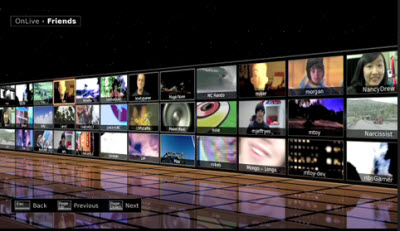
Blogger Ryan Shrout of PC Perspective managed to get a password from a friend of a friend and sneak into the closed beta test of the company’s games on demand service. And it turned out to be a bad experience. Shrout wrote about it, and a number of sites piled on, saying that the OnLive service clearly didn’t live up to its billing. Ars Technica wrote, “Is anyone surprised?”
[aditude-amp id="flyingcarpet" targeting='{"env":"staging","page_type":"article","post_id":155222,"post_type":"story","post_chan":"none","tags":null,"ai":false,"category":"none","all_categories":"business,games,","session":"A"}']Only thing was that the test Shrout conducted wasn’t fair. The company says he was too far away from its servers to do a good test.
The service is supposed to enable you to play high-end games on a low-end computer. It does so by doing the heavy duty processing in a data center, much the way other cloud applications work. Then it sends video over a broadband connection to display animations on a gamer’s computer. If all works fine, then the video and game play should be smooth, much like playing a game on a console or a high-end PC.
AI Weekly
The must-read newsletter for AI and Big Data industry written by Khari Johnson, Kyle Wiggers, and Seth Colaner.
Included with VentureBeat Insider and VentureBeat VIP memberships.
I’ve seen it work on a couple of occasions in the past. But the big test is whether OnLive can do it for hundreds of thousands or millions of players at the same time. If it works, OnLive could lower the cost of games, bypass retail, and offer online games as a service to gamers. But lots of technical experts say that OnLive can’t possibly work as well as it says. Shrout’s piece seemed to be proof positive of that. Seemed being the operative word.
Shrout said the speed was slow and the graphics unimpressive. He confirmed it has a very light memory footprint, in terms of how much main memory it uses. It also used only 4 to 7 percent of the computer’s processing power while running the racing game Burnout: Paradise. It used about 1 megabit per second of bandwidth. The PC has to be hardwired to a broadband connection and can’t be used over Wi-Fi; it also runs only at 720p resolution now (good enough for high-definition, not the greatest quality, at 1280×720). Shrout was disappointed at the lag, or delays in game animations on the screen.
The analysis was by and large good. But it turns out that Shrout was about 2,100 miles away from the company’s server in California, according to a response posted by OnLive chief executive Steve Perlman. He explains that the company “can’t overcome the speed of light” and that the user has to be within a thousand miles of an OnLive server. Otherwise, the performance degrades. OnLive plans to set up several data centers around the country so that there isn’t a huge distance between servers and users. But it hasn’t done so yet, so Shrout was evaluating the service’s performance under suboptimal conditions. The servers warned him multiple times that the conditions for the service were not good. Still, it was surprising the service actually worked.
Perlman quipped in his post, “Noobs beware.” (Noobs is slang for newbies, which is slang for a new player who doesn’t know what he or she is doing). I’m afraid we’re going to have to wait a bit longer to find out if OnLive can deliver what it says it can.
Perlman is the keynote speaker at GamesBeat@GDC, our conference in San Francisco on March 10.
VentureBeat's mission is to be a digital town square for technical decision-makers to gain knowledge about transformative enterprise technology and transact. Learn More
